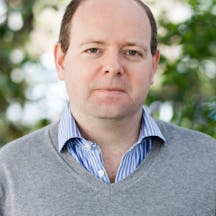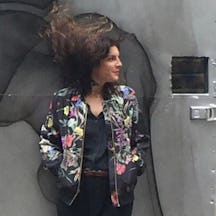When a man offered to save his dying brother’s life by donating a kidney, a surgical first became possible. For these brothers were identical twins, essential for the transplanted kidney to survive outside the donor’s body before the days of immunosuppressant drugs.
The tale of the toxic kidneys
Words by Thomas Morrisartwork by Emily Evansaverage reading time 6 minutes
- Serial

Richard Herrick’s symptoms seemed quite innocuous at first. The 23-year-old US Coast Guard officer noticed one morning in late 1953 that his eyes seemed a bit puffy, but thought no more of it until a few months later, when a routine medical revealed that he had high blood pressure. He was sent to a hospital in Boston, where he told the doctors that apart from persistent nosebleeds, he felt absolutely fine.
But his test results told a different story. He was found to have protein in his urine, and his blood contained unusually high levels of urea – a biological waste product normally removed from the circulation by the kidneys. Richard’s doctors realised that the young man’s kidneys were failing, and toxins were inexorably accumulating in his body.
Blood transfusions improved his condition temporarily, but by the summer of 1954 it was apparent that he was seriously ill. Barely able to walk and prone to unpredictable mood swings, Richard was told that there was nothing more the doctors could do. His twin brother Ronald was distraught, and suggested to David Miller, Richard’s doctor, that he would give up one of his own kidneys if he thought it would help.
It was a throwaway remark, but an opportune one. Dr Miller recalled that researchers at another Boston hospital had begun an experimental kidney transplant programme. He made a few phone calls, and on 24 October Richard Merrick was transferred to Peter Bent Brigham Hospital, under the care of the surgeon Joseph Murray. It was his last chance of a cure.
The problem of organ rejection
The idea of removing a diseased internal organ and replacing it with a healthy one had been the dream of forward-thinking medics for at least half a century. In 1912 the French-born physiologist Alexis Carrel won a Nobel Prize for his pioneering work in the field, but never succeeded in making a transplanted organ function for more than a few hours.
The challenge was not merely a matter of surgical technique: attaching a donor organ to the blood vessels of another animal was difficult, but could be done. A more intractable problem was that some mysterious process invariably caused the replacement organs to fail. Researchers eventually realised that they were being attacked by the recipient’s own immune system: the body recognised the new tissue as alien, and released antibodies into the bloodstream to destroy it.
The first attempts at transplanting human organs were all thwarted by this phenomenon, which is known as rejection. But researchers investigating the possibility of grafting donor skin on to burns patients noticed something interesting. Skin grafts donated by a close relative tended to be rejected more slowly than those taken from a stranger. But if the graft came from the patient’s identical twin, it lasted indefinitely: because donor and recipient were genetically indistinguishable, the immune system did not see the new tissue as foreign.

Illustration of the kidneys, 1696
Joseph Murray first became aware of this anomaly while trying to repair the faces and limbs of servicemen who had suffered horrific burns during World War II. His interest in skin grafting led him to pursue the more ambitious goal of organ transplantation, and in the laboratories at Peter Bent Brigham Hospital he perfected a technique for implanting a donor kidney.
When Murray learned that Richard Merrick had a twin brother who had offered to donate a kidney, he pricked up his ears: if the young men were identical twins, a transplant might even work. Ronald and Richard certainly looked similar, but the doctors needed to be sure.
DNA testing lay decades in the future, so instead they compared the colours of the brothers’ eyes and the shapes of their ears, and matched their blood groups. A police fingerprint expert was even brought in to confirm that their prints were indistinguishable. Murray insisted on a further, more reliable test: a small patch of Ronald’s skin was grafted on to Richard’s leg. It thrived, indicating that the brothers were genetically identical.
A question of ethics
But the situation raised unprecedented ethical questions. Even if Ronald was willing to act as organ donor, was it justifiable to subject a perfectly healthy person to a risky procedure purely for the benefit of somebody else?
Dr Murray sought, and received, approval from a range of medical, legal and religious experts before deciding to go ahead. The brothers were made fully aware of the dangers, but Ronald was unyielding: he wanted to give his brother a last shot at life.
By now Richard’s condition was becoming alarming. His sky-high blood pressure was causing his heart to fail; he also had periods of psychosis, attacking the nurses and accusing them of sexual assault. Fortunately the hospital owned a kidney dialysis machine – one of the first in the world – and this was used periodically to flush the toxins out of his body, temporarily improving his mental and physical state.
Was it justifiable to subject a perfectly healthy person to a risky procedure purely for the benefit of somebody else?
At 08.00 on 23 December, Richard and Ronald Herrick were taken to adjoining operating theatres and anaesthetised. While Joseph Murray began the operation on Richard, next door his colleague John Hartwell Harrison was removing Ronald’s healthy left kidney.
To ensure that the organ was not starved of oxygen for a second longer than necessary, Hartwell Harrison waited until Murray indicated that he was ready before cutting the organ off from Ronald’s circulation. The kidney was then carried next door, where Murray carefully connected it to Richard’s blood vessels. After almost 90 minutes the job was done.
The team watched anxiously as Murray removed a clamp, allowing blood to flow through the transplanted organ for the first time. After a few seconds the kidney turned a healthy pink, and then started to produce a steady flow of urine. The medics looked at each other and breathed a sigh of relief.
A brother’s life-saving gift
Ronald made an uneventful recovery and was discharged from hospital a fortnight later, none the worse for the loss of a kidney. Meanwhile, the improvement in Richard’s condition was spectacular. He gained weight rapidly and his mental state returned to normal. He even fell in love with one of the nurses looking after him; they later married and had two children.
Richard subsequently required two further operations to remove his own failed kidneys, but within months he was living a normal life. His brother’s astonishing Christmas present had apparently saved him. Richard lived for another eight years with his new kidney before dying from a heart attack – the consequence not of the operation, but of the disease that had preceded it.
The Merrick operation was the world’s first successful organ transplant. There had been little danger of rejection, since donor and recipient were genetically identical; using an organ from an unrelated donor would have been a far more daunting challenge.
Joseph Murray remained at the cutting edge of transplant surgery for the next two decades, pioneering the use of immunosuppressive drugs to prevent rejection. But his first successful operation in 1954 had shown that the procedure was viable and could save lives: the transplant age had begun.
About the contributors
Thomas Morris
Thomas Morris is author of ‘The Matter of the Heart’ and more recently ‘The Mystery of the Exploding Teeth and Other Curiosities from the History of Medicine’. He has worked as a radio producer for the BBC on such programmes as ‘Front Row’, ‘Open Book’ and Melvyn Bragg’s ‘In Our Time’, and his journalism has appeared in publications including the Lancet and the Times.
Emily Evans
Emily Evans is a medical illustrator and anatomist. After her role as a senior demonstrator of anatomy at Cambridge University, alongside her career illustrating medical and surgical books for over a decade, she now writes and publishes books about anatomy and art, such as ‘Anatomy in Black’, while running her brand, Anatomy Boutique.

